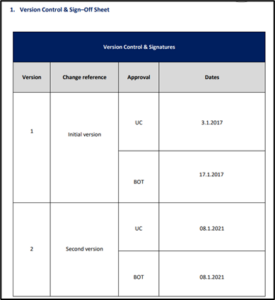ASU Strategic Plan
https://www.asu.edu.bh/wp-content/uploads/2022/01/ASU-Strategic-Plan-Final.pdf

Quality is a main objective in ASU strategic plan as shown below:

Equality and Diversity Policy
https://www.asu.edu.bh/wp-content/uploads/2021/11/Student-Handbook-English-2022-2021.pdf
Policy Statement
This policy outlines the commitment of Applied Science University to create an environment where differences are valued and equality of opportunity is evident among all staff, students, and any stakeholder.
- This policy defines certain actions that are not permissible and that are considered unlawful. These are called ‘Types of Discrimination’.
- It also identifies so-called ‘protected characteristics’ which are best described as certain attributes that regular people possess which the University considers should be safeguarded. When ‘safeguarded’ it means against the ‘Types of Discrimination’.
The Applied Science University is fully committed to promoting equality of opportunity and fairness and to eliminate discrimination against all national and international staff, students, and anyone associated with the University (e.g. visitors, contractors and service providers) regardless of:
- Age
- Disability
- Marital Status
- Pregnancy and Maternity
- Race (colour, ethnicity, or nationality)
- Religion or Belief
- Gender h. Unfair Dismissal
No kinds of discrimination, harassment, or bullying are tolerated at the Applied Science University.
Equality and Diversity Policy

Version Control & Sign–Off Sheet

Protected Characteristics
4.1 Age
The university protects people of all ages and works within the legal framework for employment in the Kingdom of Bahrain. Different treatment because of age is not unlawful and does not constitute direct or indirect discrimination if it can be justified on the grounds of effective and efficient work procedures, i.e. if it can be demonstrated that it is a proportionate means of meeting a legitimate aim.
4.2 Disability
The university has made it easy for any employee to declare that they are disabled and it is an expectation of the University that any physical or mental is declared in order to ensure that individuals are protected from disability discrimination. Under this policy, a person is considered disabled if they have a physical or mental impairment which has a substantial and long term adverse effect on their ability to carry out normal day-to-day activities as described in their job specification. Where possible the University will make reasonable adjustments to allow a member of staff who is disabled to carry out their duties effectively.
4.3 Marriage
The policy protects employees who are married against discrimination and in particular makes reasonable adjustments to assist new employees to ensure that they do not need to be separated for an unduly long period from their immediate family.
4.4 Family circumstances
A woman is provided with particular rights and considerations on the grounds of pregnancy and maternity – during the period of her pregnancy and any statutory maternity leave to which she is entitled. During this period, these arrangements cannot be viewed by other employees as sex discrimination.
4.5 Race
For the purposes of this policy ‘race’ includes color, nationality and ethnic or national origins.
4.6 Religion or belief
Religion includes any religion. It also includes a lack of religion, in other words employees or jobseekers are protected if they do not follow a certain religion or have no religion at all.
4.7 Gender
Both men and women are treated equally and protected under this policy.
Types of Discrimination
5.1 Direct Discrimination
This occurs when any stakeholder is treated less favorably than another person because of a “Protected Characteristic”.
5.2 Associative Discrimination
This is discrimination against any stakeholder because they have an association with someone with a particular “Protected Characteristic”.
5.3 Perceptive Discrimination
This is discrimination against any stakeholder because the discriminator thinks the person possesses a protected characteristic, even if they do not in actually do so.
5.4 Indirect Discrimination
This occurs where a policy, rule or procedure applies to everyone but has a disproportionate impact on people with a protected characteristic. The University is assiduous in considering the rights of all its employees and does not develop and implement policies which lead to indirect discrimination.
Responsibilities and commitment
6.1 All staff, students and anyone associated with the University must accept the principle that there is equality of opportunity and fairness for all staff and students in all aspect of University life.
6.2 In their day-to-day work all staff, students and anyone associated with the University must ensure they do not support unfair behavior by ignoring what is happening around them and must not incite with unfair or unlawful discrimination.
6.3 All staff, students and anyone associated with the University, have a responsibility to adhere to this policy and apply it in their day to day work. The specific responsibilities in relation to this policy are as follows:
6.3.1 The University is ultimately responsible for ensuring that it fulfils its legal responsibilities for promoting equality and eliminating discrimination, and for making sure that the commitments within this policy are fulfilled.
6.3.2 The President, having the overall leadership for running the University, has the responsibility for ensuring that the legal responsibilities for promoting equality and eliminating discrimination, and for making sure that the commitments within this statement are fulfilled across the University.
6.3.3 HRD is responsible for implementation of this policy with respect to staff and also for implementing related policies and procedures. HRD will also ensure that all staff receive appropriate equality and diversity inclusion training.
6.3.4 The Dean of Student Affairs is responsible for implementation of this policy with respect to students and also for implementing related policies and procedures.
6.3.5 Deans of Colleges/Heads of Department have a responsibility for ensuring that all staff and students are aware of the commitments within the policy. They also have a responsibility to promote equality of opportunity and to eliminate discrimination within their Colleges/Departments
Complaints of Discrimination or Harassment
7.1 If a member of staff feels that they have been discriminated against, the complaint should be raised in accordance with the appropriate University Grievance Procedure, in general, any such grievance is to be reported to HRD either via email ([email protected]), a written letter or in person.
7.2 If a student feels that they have been discriminated against, the complaint should be raised in accordance with the University’s Code of Practice on Complaints, Appeals and Discipline.
7.3 If a member of staff or student feels that they are being bullied or harassed, the complaint should be raised in accordance with the University’s Harassment and Bullying Policy.
7.4 Advice on the use of these procedures can be obtained from Human Resources and Student Services.
Any member of the University community found to be responsible for inciting, perpetrating or colluding with discrimination may face disciplinary action that may lead to termination or prosecution.
ASU Research Policy
https://www.asu.edu.bh/wp-content/uploads/2019/07/ASU-Research-Policy.pdf
This Policy applies to:
- All faculty members who may conduct any research activity at the University.
- All University students (undergraduate and postgraduate students) who conduct any research activity at the University.
- Employees involved in administrative procedures for any research activity.
In the below application forms, we notice that there is never a mention about the gender:
Research Funding Application Form

Application Form for Participation in a Conference

Application Form for Publication Fees



